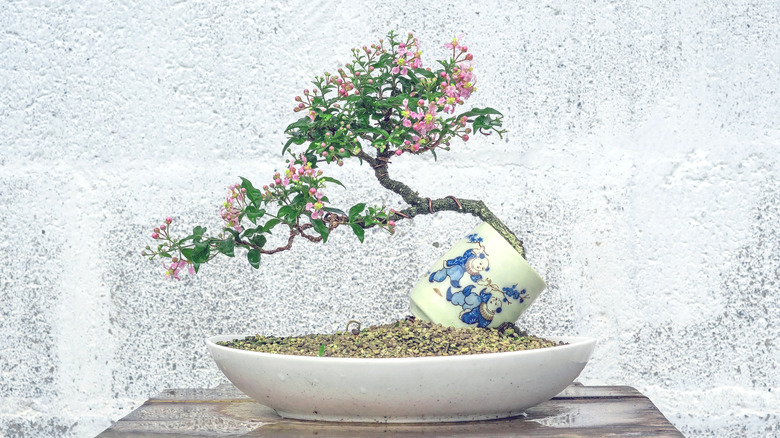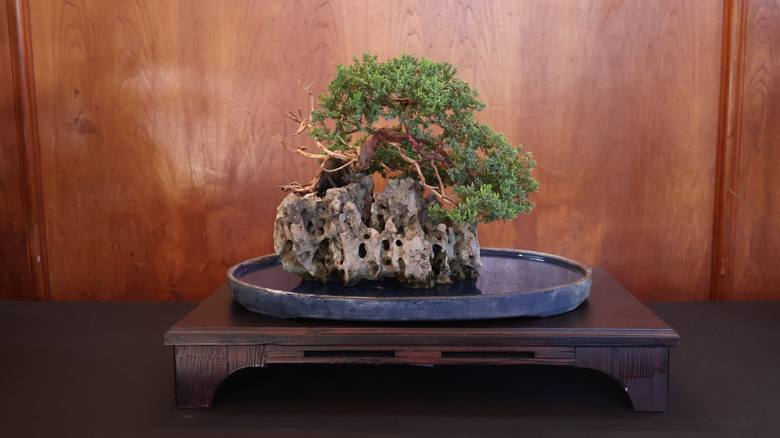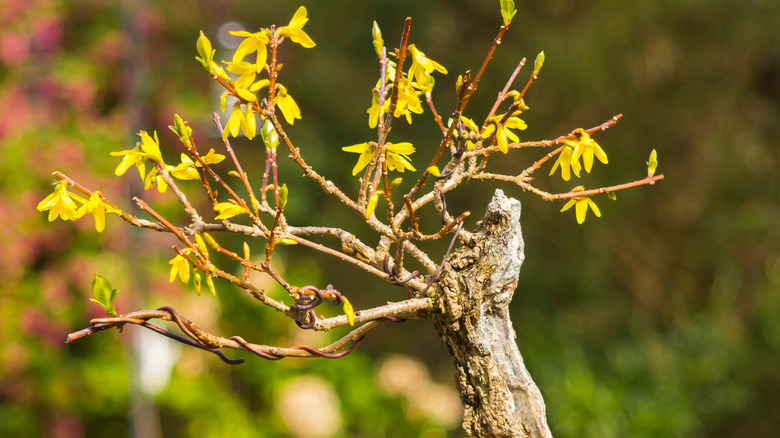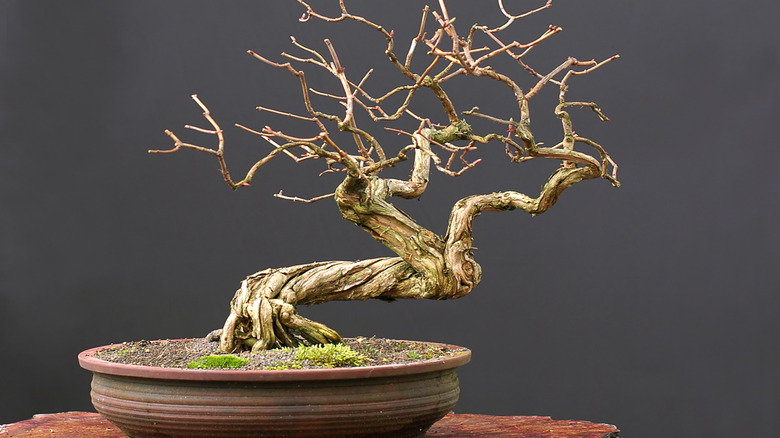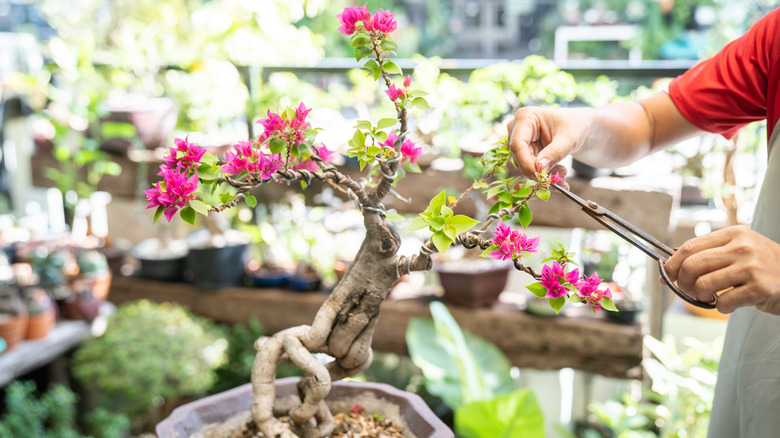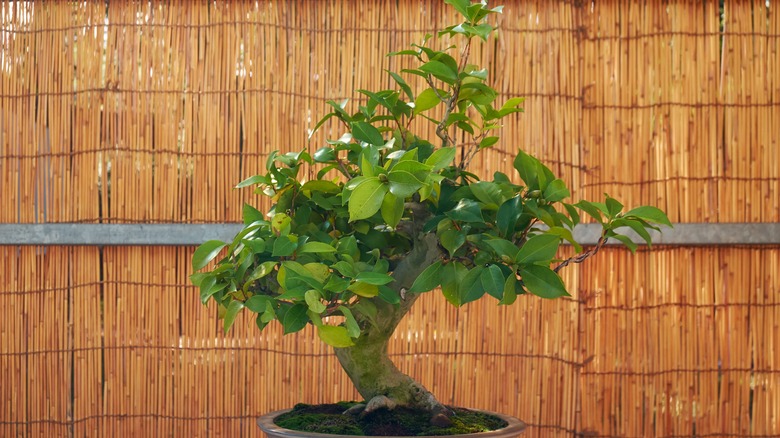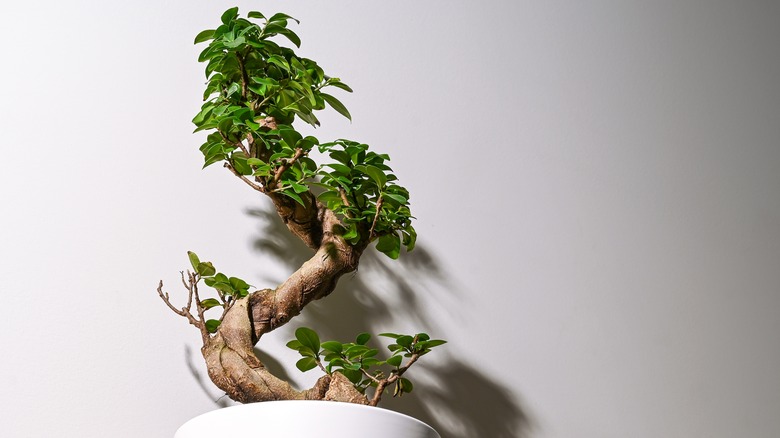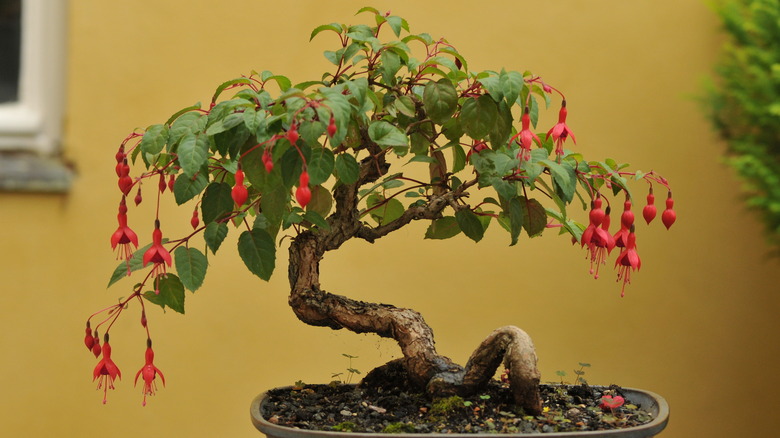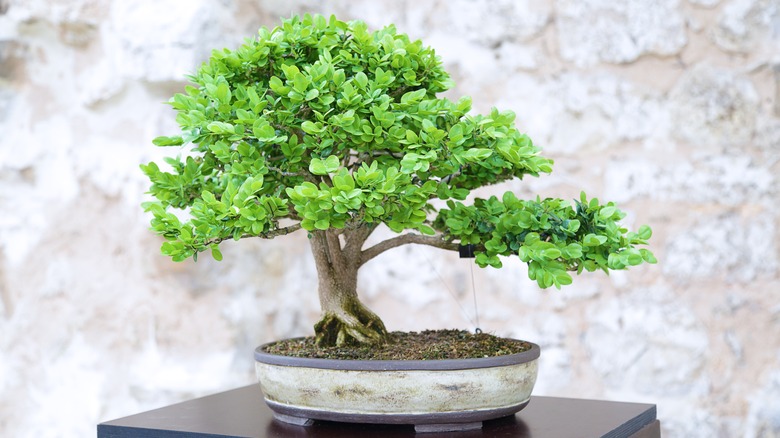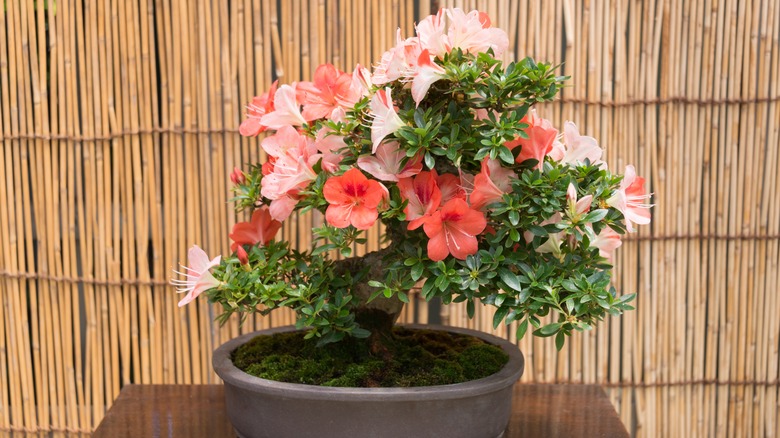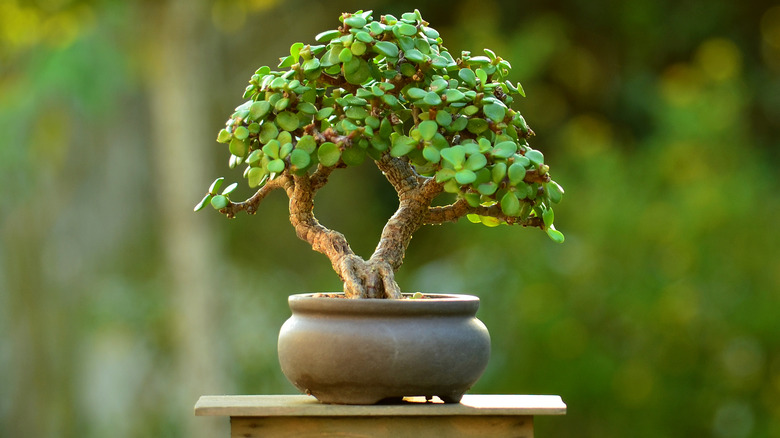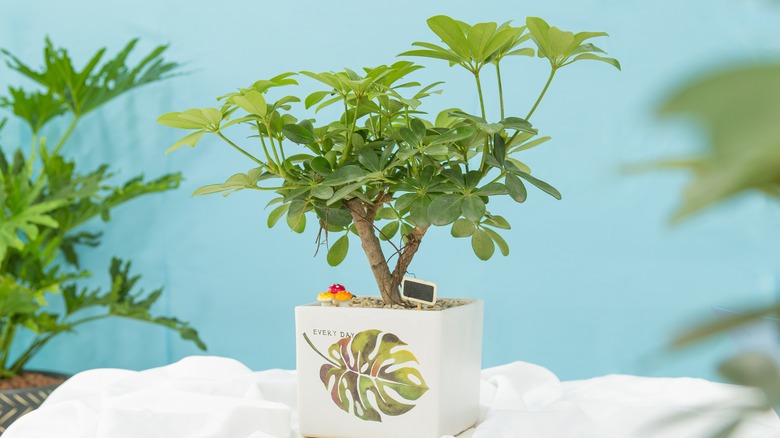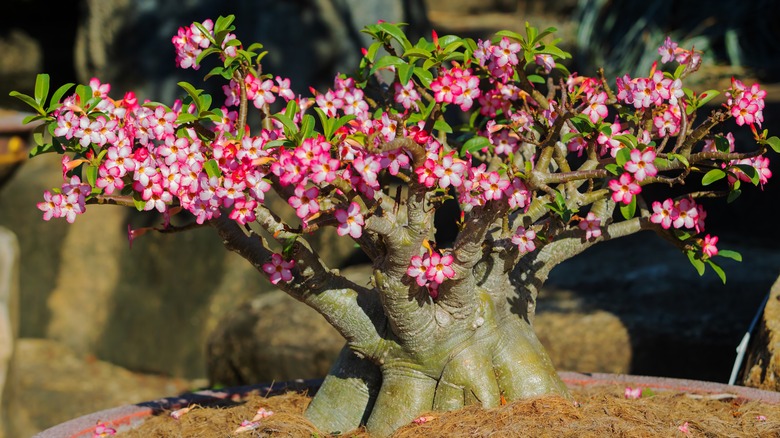13 Common Shrubs That Can Actually Become Stunning Bonsai Trees
Perhaps because they look exotic, delicate, and fiddly, it's easy to miss that common, hardy shrub species often make excellent bonsai. Indeed, any woody perennial has a decent chance of making a good bonsai. And while we consider them trees, only the mature bonsai needs the tree-like shape, which is often easy to coax from a shrub.
A lot of the characteristics that define what can technically be styled as bonsai are matched by common shrubs, such as boxwoods, junipers, and azaleas. They must, for example, be able to cope with a typical shallow bonsai pot, and they must be able to handle root pruning. They must also react properly to pruning — including sometimes reducing leaf size so that the foliage is proportional to the overall bonsai. Once you've found a shrub that does these things well, of course, you must also be happy with the way the shrub looks when styled. Our list of shrubs that are suitable as bonsai largely satisfies these requirements, making them good choices for beginner bonsai.
Juniper
Juniper (Juniperus spp.) is an excellent shrub for beginners to start a bonsai journey with because it's easy to get good results, even in styles like kengai (cascade) or han-kengai (semi-cascade) bonsai that look more difficult than they are. Because of the way juniper has a natural growth habit that spreads branches downward and away from canopy shade. It's easy to coax a kengai bonsai from many cultivars of juniper, including the common Chinese juniper commonly found in landscapes (and garden centers). Position your juniper bonsai in full sunlight and pinch shoot tips as they appear. Juniper is commonly propagated via cuttings.
Forsythia/dwarf forsythia
Bonsai aren't always known for their showy flowers, but the bright yellow spring flowers of the deciduous forsythia (Forsythia intermedia) demand an exception. You'll get three seasons of beautiful bonsai with forsythia since the thick trunks make the plant interesting even when it is leafless. Then comes the early spring explosion of flowers, probably the highlight of the year, and a leafed-out growing season. Dwarf varieties work great for small (shohin and mame) bonsai and produce tiny brown fruit. Place forsythia in full sun and trim back new shoots. You can propagate forsythia by seeds, cuttings, or grafting.
Dwarf honeysuckle
Dwarf hedging honeysuckle (Lonicera nitida), with its small evergreen leaves, makes a reliable and classic bonsai. It's sometimes referred to as privet honeysuckle, which might give you pause since Japanese honeysuckle and most privets are invasive, but L. nitida is not invasive and spreads via rhizomes, meaning it won't cause any problems from a bonsai pot. Give it full light and perhaps a little protection from direct sun in summer, and prune aggressively during its growing season. Propagate L. nitida via cuttings.
Bougainvillea
Bougainvillea (Bougainvillea buttiana) is a genus of showy plants with various growth habits, including bush and vining varieties. It has semi-evergreen leaves, and older specimens can have thick trunks, which are perfect for bonsai. The vining species can be easily trained with wire and will later fill out with bougainvillea's oval leaves and red bracts. Give bougainvillea full sun and prune it continually to keep the plant compact. When caring for and growing your bonsai, you can propagate with cuttings.
Camellia
It might surprise you that camellia (Camellia japonica) makes a very classic medium-sized bonsai, and rather easily as well because the plant's naturally chaotic branch growth patterns leave plenty of room for shaping. The evergreen has shiny leaves that will crack if folded and pink, red, or white flowers. Give camellia partial shade, protect it from frost, and prune new growth after it has finished flowering. Propagate camellia via cuttings, layering, or seeds.
Banyan fig
Banyan fig (Ficus retusa) is technically a tree, but you can't make a list of bonsai plants without also including a ficus to bring nature into your home. The banyan fig has rather large leaves for a small or medium-sized bonsai, but the banyan-like root growth and the glossy, leathery leaves add visual interest. Give the banyan ficus low or medium light and moderate temperatures, and prune new shoots constantly — propagate banyan fig by cuttings or air layering.
Ginseng ficus
Nothing is ever simple with plant names, but we can't pass the ginseng ficus (Ficus microcarpa) by, even though it's sometimes also called banyan fig. Ginseng ficus has bulbous roots that resemble its namesake, small glossy leaves, and roots that can range from banyan-like to gnarled to not visible. Aerial root development requires an artificial, nearly 100% humid environment. Give the ginseng ficus plenty of light, and prune frequently to two-leaf branches. Propagate by cuttings, air-layering, and seed.
Fuchsia
Given its large leaves for a small bonsai, fuchsia (Fuchsia spp.) can be coaxed into quite a variety of bonsai shapes. One of these, surprisingly, is kengai, made possible by the drooping habit of fuchsia's flowers and leaves, and the shape is maintained throughout the seasons by the evergreen leaves. Keep fuchsia in full sun and above-freezing temperatures, and prune back new growth as it appears. Propage fuchsia by cuttings.
Boxwood
What is sometimes the most mundane landscape plant, the boxwood (Buxus spp.), can make an extraordinarily beautiful — and fairly easy — bonsai. They are easy to shape with wire and have dense foliage that lends itself to classic bonsai shapes. Common European boxwood, Chinese boxwood, and Japanese boxwood are the varieties most commonly used for bonsai. Position boxwood outside in a sunny or semi-sunny area and prune aggressively — propagate boxwood via cuttings or air layering.
Azalea
The thick stems and small, glossy leaves of most azalea cultivars make it an excellent candidate for styling as bonsai. You will also appreciate its profusion of flowers from May through June, especially from the Satsuki azalea (Rhododendron indicum) that's popular for bonsai. Deadhead azaleas frequently for more vigorous new growth. Position it outdoors in semi-shade and prune aggressively, as even leafless azalea branches can produce new growth. You can propagate azalea by cuttings or air layering.
Dwarf jade
Dwarf jade (Portulacaria afra), a common succulent houseplant with woody stems, is also a common choice for bonsai. Its thick trunk and comparatively thin branches make for an interesting visual contrast. In spite of the thick trunk, your young bonsai is likely to get top-heavy, so allow yourself to take cuttings for sharing or future bonsai. Give jade a few hours of direct sunlight each day, and remove new shoots in spring, or prune branches throughout the growing season. Propagate jade via cuttings in the summer.
Dwarf schefflera
At first glance, you might not think that dwarf schefflera (Schefflera arboricola) would make much of a bonsai, but it turns out to be one of the more flexible and easily trained plants used for indoor bonsai in a variety of sizes and styles. Schefflera is easy to grow and coax a lot of character out of for your bonsai. Position schefflera where it will get plenty of light and stay warm.
Desert rose
Desert rose (Adenium obesum) makes for a striking bonsai in its growth habit, bulbous base, small succulent leaves, and striking flowers. Of all the shrubs discussed here, desert rose might have the most potential for creating a truly remarkable bonsai as a beginner. A desert rose might lose its leaves in winter in certain climates. Don't be alarmed; they'll be back. Position desert rose outdoors in a sunny spot and keep it warm, pruning year-round. Propagate desert rose by seeds or cuttings.
